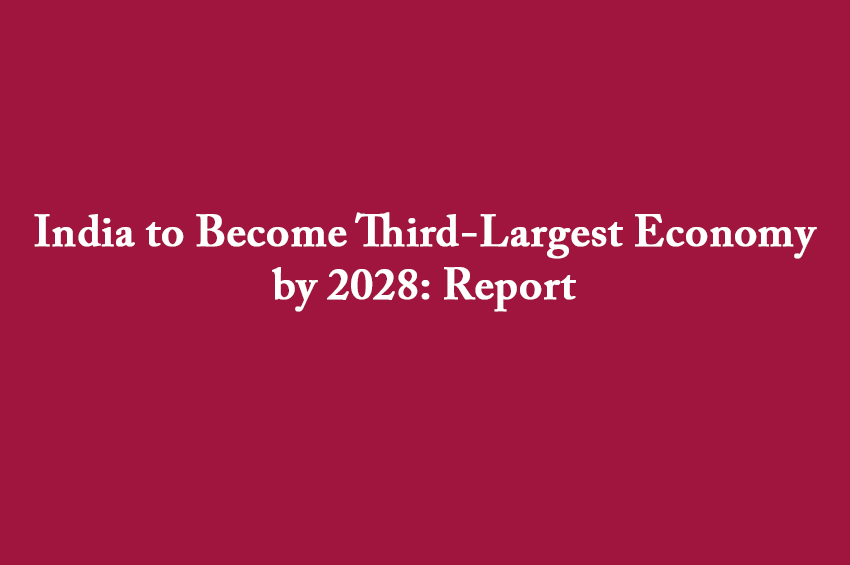Winning Bizness Economic Desk
India is set to become the third-largest economy by 2028 and see its Gross Domestic Product (GDP) double to USD 10.6-trillion by 2035, a report by the globally-renowned firm Morgan Stanley said.
India’s economic expansion will be propelled by its states with three-to-five states including Maharashtra, Tamil Nadu (TN), Gujarat, Uttar Pradesh (UP) and Karnataka expected to reach the USD 1-trillion mark, the Morgan Stanley report stated.
The financial services firm said that the top three states as on date are Maharashtra, Gujarat and Telangana with states such as Chhattisgarh, Uttar Pradesh and Madhya Pradesh (MP) exhibiting tremendous improvements in their economic rankings in the previous five years.
Moreover, in the next few years, the country is likely to account for 20 per cent of the global growth, driving the earnings of multi-national corporations, the Morgan Stanley report stated.
India’s GDP Growth Projections Lowered by ADB and Ind Ra
The Asian Development Bank (ADB) and India Ratings and Research have both lowered their GDP growth projections for India for the current fiscal year (FY 26).
They have cited the negative impact of the United States’ tariff policies and weak demand and investment climate as reasons for lowering the country’s economic growth projections.
In its Asia Development Outlook 2025 update, the Asian Development Bank has lowered the country’s GDP growth projection for FY 26 to 6.5 per cent from its earlier projection of 6.7 per cent it had made in April.
Here, it must be pointed out that ADB has also reduced its 2026-27 (FY 27) growth projection by 10 basis points (bps) to 6.7 per cent.
In the last financial year ended March 31, 2025 (FY 25), India’s GDP had expanded by 6.5 per cent.
The downgrade for this fiscal year has been driven by expectations of reduced exports amid higher US tariffs and global trade uncertainty coupled with a weaker domestic demand.
Despite the slowdown, the country would remain one of the fastest-growing major economies in the world, the Manila-headquartered ADB said.
India Ratings and Research (Ind Ra) also lowered its GDP growth projections for the country. For the present financial year (FY 26), it has revised southward its growth projection to 6.3 per cent from its earlier estimate of 6.6 per cent announced in December of last year (2024).
The firm’s Chief Economist and Head, Public Finance, Mr Devender Kumar Pant, said that the economy was confronted with both headwinds and tailwinds.
According to Mr Pant, major headwinds include uncertain global scenarios from the unilateral tariff hikes by the United States for all countries and a weaker-than-expected investment climate.
A point that needs highlighting here is that the ADB has downgraded its forecast on most of the economies in developing Asia and Pacific.
The growth forecast for developing Asia and the Pacific region has been lowered by 20 basis points to 4.7 per cent for 2025.
India’s Coffee Export Shipments Rise 125 pc in 11-Years
India’s coffee shipments increased by 125 per cent in the past eleven-years, touching USD 1.8-billion in 2023-24, up from the USD 800-million in 2014-15, according to central government data.
The northward movement in exports is attributed to a series of policy measures implemented by the Coffee Board of India, including distribution of permits, export incentives and support for value-addition in processing.
As per the data, exports stood at USD 1.28-billion in 2023-24 as compared to USD 1.14-billion in 2022-23.
Europe continues to be the top destination for Indian coffee with key markets being Italy, Germany, Belgium, the Middle-East countries, South Korea and Japan.
With a view to bolster exports, the Coffee Board has taken steps such as digital issuance of RCMC, export permits and certificates of origin, regular engagement with exporters to address problems and providing global market intelligence.
Additionally, the government has introduced transit and freight assistance offering Rs 3 per kg for value-added exports and Rs 2 per kg for hi-value green coffee shipments to far-off markets such as the United States, Canada, Japan and the Nordic countries.
The Coffee Board also offers a forty per cent subsidy on machinery costs to further assist domestic processors and entrepreneurs.
This is capped at Rs 15-lakh for roasting, grinding and packaging units.
What needs to be highlighted here is that India is the seventh largest coffee producer globally with a 3.5 per cent share and ranks fifth in exports with a five per cent global share.
India produces about 3.6-lakh tonnes of coffee annually with the three southern states Karnataka, Kerala and Tamil Nadu being top growers.
ICRA Lowers India’s Construction Sector’s Growth Forecast for FY 26
Rating agency ICRA has revised its revenue growth forecast for the Indian construction industry this fiscal (FY 26) to 6-to-8 per cent from its earlier projection of 8-to-10 per cent.
According to the ICRA report, this downgrade stems from sluggish activity in road projects and delayed execution in the Jal Jeevan Mission of the central government.
However, the report states that despite these hurdles, a recovery is expected compared to the flat performance registered last fiscal (FY 25). This recovery will be propelled by growths in urban infrastructure and irrigation segments.
The rating agency expects profitability in this sector to remain constrained, forecasting operating margins in a narrow range of 10.25-to10-.75 per cent for FY 26, marginally lower than the 10.6 per cent in FY 25.
This is a sharp southward movement from the peak margin range of 13-to-14 per cent seen in FY 21, primarily due to rising consumption and aggressive bidding practices.
According to Mr Suprio Banerjee, Vice-President and Co-Group Head, Corporate Ratings at ICRA, “The order inflows in FY 25 registered a YoY decline of 19 per cent, primarily impacted by the general election during H1 FY 25. The contractors, focussed largely on the road segment are likely to under-perform, compared to broader trends owing to the slowdown in order-awarding activity from the MoRTH/NHAI.”
“Several mid-sized road construction entities have order-book revenues of less than 2.0 times, indicating imminent stress on their revenue prospects in FY 26 far below the industry average of around 3.5 times,” he added.
India’s Forex Reserves Slide to USD 695.49-bn
The country’s foreign exchange reserves slid for the third week in a row to USD 695.49-billion for the week ended July 18, 2025, according to data from the Reserve Bank of India (RBI).
The country’s forex kitty fell by USD 1.18-billion over the previous reporting week. In that week, the reserves had dropped by USD 3.06-billion to USD 696.67-billion.
The Reserve Bank’s forex holdings had steadily recovered in the first six months of this calendar year (CY), but the numbers have slid in the last three weeks.
The southward movement can be attributed to robust central bank intervention in the currency market to support the Rupee (India’s currency) amid a strong dollar.
The country’s central bank typically sells dollars from its reserves when the local currency is under pressure to curb excessive volatility.
For the week ended July 18, the Foreign Currency Assets (FCAs)—a major component of the reserves—declined USD 1.2-billion to USD 587.61-billion.
In dollar terms, the FCAs include the effect the appreciation or depreciation of non-US units such as the Euro, the Pound and the Japanese Yen held in the forex reserves.
India ranks as the fourth largest holder of forex reserves, sufficient to cover nearly a year of imports.
The country’s forex holdings are the fourth largest after China, Japan and Switzerland.


